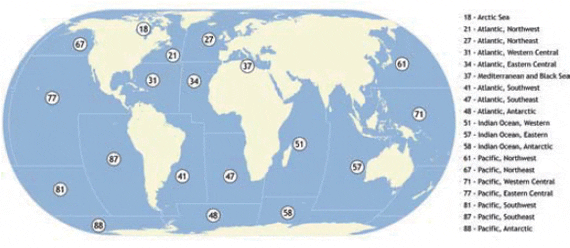Introduction
Marine fisheries are very important to the economy and well-being of coastal
communities, providing food security, job opportunities, income and livelihoods as
well as traditional cultural identity. They produced 80 million tonnes of fish in 2009
and directly employed 34 million people in fishing operations in 2008 (FAO, 2010).
Fish and fishery products are a vital and affordable source of high-quality protein,
especially in the worlds poorest nations in 2008, fish supplied more than three billion
people with at least 15 per cent of their average animal protein intake (FAO, 2010).
Therefore, maintaining the long-term prosperity and sustainability of marine fisheries
is not only of political and social significance but also of economic and ecological
importance.
The United Nations Convention on the Law of the Sea (UNCLOS), the
United Nations Fish Stocks Agreement (UNFSA [UN, 1995]) and the FAO Code of
Conduct for Responsible Fisheries (FAO, 1995a) all require maintaining or restoring fish
stocks at levels that are capable of producing their maximum sustainable yield (MSY).
To fulfil the objectives of these international treaties, fishery management authorities
need to undertake assessment of the state of fish stocks and develop effective policies
and management strategies. As the United Nations (UN) Agency with a mandate for
fisheries, FAO has an obligation to provide the international community with the best
information on the state of marine fishery resources.
FAO undertook an assessment of marine fishery resources in 1973, originally at the
request of the Sea Bed Committee in preparation for the UN Conference on the Law of
the Sea. The FAO Committee on Fisheries (COFI) in its Eighth Session report expressed
the view that such an appraisal of the worlds fishery resources should be updated with
the most recent statistics and presented at future COFI meetings (FAO, 1974).
This effort
to assess and report on the state of global marine fishery resources was then followed up
through a series of brief summary updates (FAO, 1974, 1978, 1979, 1981, 1983, 1985, 1987,
1989, 1990, 1992). These reports were prepared as background information documents
for the regular sessions of COFI.
This reporting became a series of regular stand-alone
publications (FAO, 1994, 1995b, 1997a) and later as contribution sections to the FAO
flagship publication The State of World Fisheries and Aquaculture (FAO, 1997b, 1999,
2000, 2002, 2004). The State of World Fisheries and Aquaculture also has a primary objective
of providing updated information to COFI. It also provides an update, more generally, to
policy-makers, civil society and all those who derive their livelihood from fisheries and
aquaculture, while covering a much broader range of issues affecting these sectors.
FAO Marine Major Fishing Areas for Statistical Purposes

The publication presents a major assessment and update since the last comprehensive
review in 2005 (FAO, 2005). It is an update on the state of world marine fishery
resources provided in the most recent biennial updates for The State of World Fisheries
and Aquaculture 2010 (FAO, 2010). While the general focus and outlay of previous
major reviews have been maintained to the extent possible, several changes have been
introduced in this volume in response to comments and suggestions received from
readers and collaborators. It is also the intention of FAO to make better use of hardcopy
and electronic Web-based publishing possibilities.
This review consists of four major components. The first part provides a global
overview of marine fishery production and the state of marine fish resources
(Chapter A1).
The second part is divided into chapters that
summarise and compile the information available for each FAO major fishing area for
statistical purposes (Figure A1).
The third part focuses on special topics that attract
great attention in the international community, including tuna and tuna-like species,
sharks, the Pacific islands region, deep-sea fisheries, and fisheries and long-term climate
variability.
The final part lists all the tables that provide details about
trends in catches and, where feasible, on the state of exploitation of stocks.
The final
set of tables summarises and complements the reviews by major fishing areas
and main species groups organized according to the International Standard Statistical
Classification of Aquatic Animals and Plants (ISSCAAP) grouping.
April 2012

